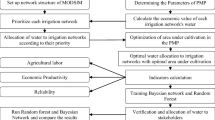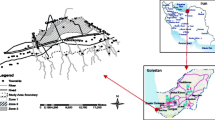Abstract
This paper describes the development of a participatory decision support system for water management in the Upper Guadiana basin in central Spain where there has long been competition for groundwater resources between the agricultural sector and the environment. In the last few decades the rapid development of irrigation has led to the over-exploitation of the Mancha Occidental aquifer, the main water source in the area; this in turn has led to the loss of ecologically important wetlands. Against this background the River Basin Authority (RBA) has designed a new water management plan aimed at reducing water consumption. The objective of this paper is to evaluate the impact of these measures on both the environment and the agricultural sector. To this end stakeholders have been invited to actively participate in the development of a decision support system (DSS) based on the combination of an agro-economic model and an object-oriented Bayesian network. This DSS has been used to evaluate the trade-off between agriculture and the environment for different management options at different scales. Results indicate that achieving even a partial recovery of the aquifer water levels will require strict enforcement by the RBA of water restrictions on farmers combined with a high offer price for the purchase of water rights. However, compliance with water restrictions inevitably leads to losses in farm income, especially in small vineyard farms, unless additional measures are taken to compensate for those potential losses. The purchase of water rights alone is insufficient to ensure the recovery of water levels; accompanying measures included in the new regional management plan will also need to be undertaken.
Similar content being viewed by others
References
Alary V, Deybe D (2005) Impacts of different water tariff reforms on rural livelihood and water and public resource in India: the case of Haryana producers. Int J Water 3:84–99
Ames DP, Neilson BT, Stevens DK, Lall U (2005) Using Bayesian networks to model watershed management decisions: an East Canyon Creek case study. J Hydroinform 7:267–282
Antunes P, Santos R, Videira N (2006) Participatory decision making for sustainable development—the use of mediated modelling techniques. Land Use Pol 23:44–52
Bacon PJ, Cain J, Howard DC (2002) Belief network models of land manager decisions and land use change. J Environ Manag 65:1–23
Bangsø O, Wuillemin PH (2000) Top-down Construction and Repetitive Structures Representation in Bayesian Networks, Proceedings of the thirteenth international Florida artificial intelligence research society conference, The AAAI Press, Menlo Park, CA. 282–286
Batchelor C, Cain J (1999) Application of belief networks to water management studies. Agr Water Manag 40:51–57
Borowski I, Hare M (2007) Exploring the gap between water managers and researchers: difficulties of model-based tools to support practical water management. Water Resour Manag 21:1049–1074
Bromley J (2005) MERIT Project Guidelines. Guidelines for the use of Bayesian Networks as a participatory tool for Water Resources Management. A MERIT report. Centre for Ecology and Hydrology, Wallingford, UK, 118 pp
Bromley J, Jackson NA, Clymer OJ, Giacomello AM, Jensen FV (2005) The use of Hugin to develop Bayesian networks as an aid to integrated water resource planning. Environ Model Softw 20:231–242
Cain J (2001) Planning improvements in natural resources management. Guidelines for using Bayesian networks to support the planning and management of development programmes in the water sector and beyond. Centre for Ecology and Hydrology, Wallingford, UK. 136 pp
Cain J, Batchelor C, Waughray D (1999) Belief networks: a framework for the participatory development of natural resource management strategies. Environ Dev Sustain 1:123–133
Cain J, Jinapala K, Makin IW, Somaratha BR, Ariyaratna BR, Perera LR (2003) Participatory decision support for agricultural management. A case study from Sri Lanka. Agr Syst 76:457–482
C.H.G. (Confederación Hidrográfica del Guadiana) (2007a) Plan Especial Del Alto Guadiana. Documento De Síntesis. CHG, Ciudad Real, Spain
C.H.G. (Confederación Hidrográfica del Guadiana) (2007b) Régimen de explotación para el año 2007 de la Unidad Hidrogeológica de la Mancha Occidental y de un perímetro adicional de la Unidad Hidrogeológica de la Sierra de Altomira. CHG, Ciudad Real, Spain
Cittadini ED, Lubbers MTMH, de Ridder N, van Keulen H, Claassen GDH (2008) Exploring options for farm-level strategic and tactical decision-making in fruit production systems of South Patagonia, Argentina. Agr Syst 98:189–198
Coleto C, Martínez-Cortina L, Llamas MR (2003) Conflictos Entre El Desarrollo De Las Aguas Subterráneas y La Conservación De Los Humedales: La Cuenca Alta Del Guadiana. Ediciones Mundi-Prensa, Madrid
Costanza R, Ruth M (1998) Using dynamic modeling to scope environmental problems and build consensus. Environ Manage 22:183–195
De Kok JL, Kofalk S, Berlekamp J, Hahn B, Wind H (2009) From design to application of a decision-support system for integrated river-basin management. Water Resour Manag 23(9):1781–1811
De la Hera A (2003) Caracterización de los humedales de la cuenca alta del Guadiana. In: Coleto C, Martínez-Cortina L, Llamas MR (eds), Conflictos Entre El Desarrollo De Las Aguas Subterráneas y La Conservación De Los Humedales. Mundiprensa, Madrid, pp 165–196
Fornés JM, de la Hera A, Llamas MR (2005) The silent revolution in groundwater intensive use and its influence in Spain. Water Policy Not Known, pp 1–16
Garrido A, Varela-Ortega C (2008) Economía del agua en la agricultura y políticas sectoriales. Panel de Estudios. Universidad de Sevilla-Ministerio de Medioambiente
Giordano R, Passarella G, Uricchio VF, Vurro M (2007) Integrating conflict analysis and consensus reaching in a decision support system for water resource management. J Environ Manag 84:213–228
Global Water Partnership (2000) Integrated Water Resources Management. TAC Background Paper N° 4. Global Water Partnership, Stockholm, Sweden
Gómez-Limón JA, Riesgo L (2004) Irrigation water pricing: differential impacts on irrigated farms. Agr Econ 31:47–66
Gurung TR, Bousquet F, Trébuil G (2006) Companion modeling, conflict resolution, and institution building: sharing irrigation water in the Lingmuteychu Watershed, Bhutan. Ecol Soc 11:36
Hugin Expert A/S (2008) Hugin Researcher, version 6.9. User’s Guide
Janssen S, van Ittersum MK (2007) Assessing farm innovations and responses to policies: a review of bio-economic farm models. Agr Syst 94:622–636
Jensen FV (2001) Bayesian networks and decision graphs. Springer, New York
Jensen FV, Nielsen TD (2007) Bayesian networks and decision graphs. Springer, New York
Jury WA, Vaux HJ (2007) The emerging global water crisis: managing scarcity and conflict between water users. Adv Agron 95:1–76
Koller D, Pfeffer A (1997) Object-oriented Bayesian Networks. In: Proceedings of the thirteenth annual conference on uncertainty in artificial intelligence (AI-97). Rhode Island, USA, July 1997, pp 302–313
Llamas MR, Martínez-Santos P (2005) Intensive groundwater use: silent revolution and potential source of social conflicts. J Water Resour Plann Manag 131:337–341
Lynam T, de Jong W, Sheil D, Kusumanto T, Evans K (2007) A review of tools for incorporating community knowledge, preferences, and values into decision making in natural resources management. Ecol Soc 12:5
Martín de Santa Olalla FJ, Domínguez A, Artiago A, Fabeiro C, Ortega JF (2005) Integrated water resource management of the hydro-geological unit “Eastern Mancha” using Bayesian Belief networks. Agr Water Manag 77:21–36
Martín de Santa Olalla FJ, Domínguez Padilla A, Ortega F, Artiago Ramírez A, Fabeiro Cortés C (2007) Bayesian networks in planning a large aquifer in Eastern Mancha, Spain. Environ Model Softw 22(8):1089–1100
Martínez-Cortina L, Cruces J (2005) The analysis of the intensive use of groundwater in the Upper Guadiana Basin (Spain) using a numerical model. In: Sahuquillo A, Capilla J, Martínez-Cortina L, Sánchez-Vila X (eds) Groundwater Intensive use. Taylor & Francis
Martínez-Santos P, Varela-Ortega C, Hernández-Mora N (2007) Making inroads towards adaptive water management through stakeholder involvement, the NeWater experience in the Upper Guadiana basin, Spain. International Conference of Adaptive and Integrated Water Management. Basel, Nov. 12–15
Molina JL, García-Aróstegui JL, Benavente JR, Varela-Ortega C, de la Hera A, López-Geta JA (2009) Aquifers overexploitation in SE Spain: a proposal for the integrated analysis of water management. Water Resour Manag 23(13):2737–2760
Mysiak J, Giupponi C, Rosato P (2005) Towards the development of a decision support system for water resource management. Environ Model Softw 20:203–214
Pahl-Wostl C, Kabat P, Möltgen J (2008) Adaptive and integrated water management—coping with complexity and uncertainty. Springer, Berlin
Rosell J, Viladomiu L (1997) El programa de compensación de rentas por reducción de regadíos en Mancha Occidental y Campo de MontielAutores. Revista Española De Economía Agraria 179:331–350
Sgobbi A, Giupponi C (2007) Models and decision support systems for participatory decision making in integrated water resource management. In: Anonymous Options Méditerranéennes: Série B. Études et Recherches 56. CIHEAM-IAMB, Bari (Italy), pp 259–271
Silva-Hidalgo H, Martín-Domínguez IR, Alarcón-Herrera MT, Granados-Olivas A (2009) Mathematical modelling for the integrated management of water resources in hydrological basins. Water Resour Manag 23(4):721–730
Van Asselt-Marjolein BA, Rijkens-Klomp N (2002) A look in the mirror: reflection on participation in integrated assessment from a methodological perspective. Glob Environ Change 12:167–184
Varela-Ortega C (2007) Policy-driven determinants of irrigation development and environmental sustainability: a case study in Spain. In: Molle F, Berkoff J (eds) Irrigation water pricing policy in context: exploring the gap between theory and practice. Comprehensive assessment of water management. IWMI and CABI press, pp 328–346
Varela-Ortega C (2010) The water policies in Spain: balancing water for food and water for nature. In: Ingram H, Garrido A (eds) Water for food: quantity and quality in a changing world. Rosenberg International Forum on Water Policy. Routledge Publisher, Taylor and Francis Group, Abingdon
Varela-Ortega C, Sumpsi JM, Blanco M (2003) Análisis económico de los conflictos entre el regadío y la conservación de humedales en el Alto Guadiana. In: Coleto C, Martínez-Cortina L, Llamas MR (eds) Conflictos Entre El Desarrollo De Las Aguas Subterráneas y La Conservación De Los Humedales. Mundiprensa, Madrid, pp 257–276
Varis O (1997) Bayesian decision analysis for environmental and resource management. Environ Softw 12:177
Vennix JAM (1999) Group model-building: tackling messy problems. Syst Dyn Rev 15:379–401
Vennix JAM, Andersen DF, Richardson GP, Rohrbaugh J (1996) Model building for group decision support: issues and alternatives in knowledge elicitation. In: Morecroft JDW, Sterman JD (eds), Modeling for learning organizations. Productivity Press, Inc., Portland
Videira N, Antunes P, Santos R (2009) Scoping river basin management issues with participatory modelling: the Baixo Guadiana experience. Ecol Econ 68:965–978
Winz I, Brierley G, Trowsdale S (2009) The use of system dynamics simulation in water resources management. Water Resour Manag 23(7):1301–1323
Author information
Authors and Affiliations
Corresponding author
Rights and permissions
About this article
Cite this article
Carmona, G., Varela-Ortega, C. & Bromley, J. The Use of Participatory Object-Oriented Bayesian Networks and Agro-Economic Models for Groundwater Management in Spain. Water Resour Manage 25, 1509–1524 (2011). https://doi.org/10.1007/s11269-010-9757-y
Received:
Accepted:
Published:
Issue Date:
DOI: https://doi.org/10.1007/s11269-010-9757-y




